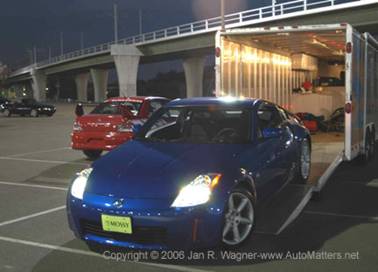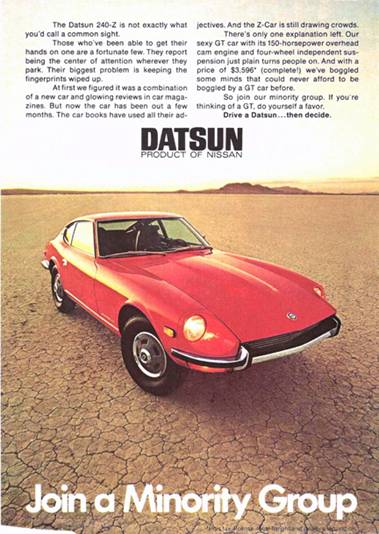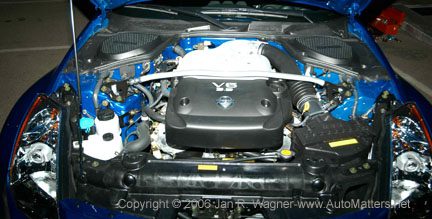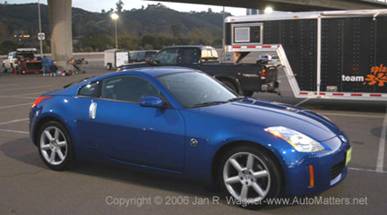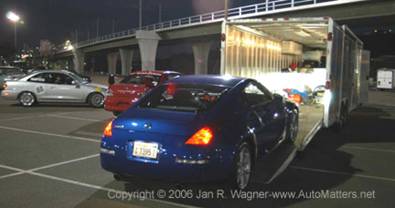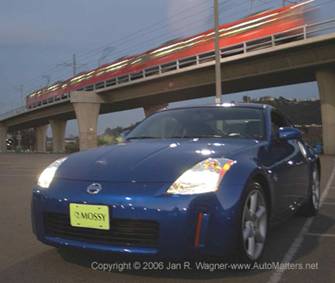
Real World Road Test: Nissan 350Z Performance Model
Every so often I get to test-drive a really FUN car. This past week the folks at Mossy Nissan in Oceanside put me behind the wheel of a beautiful, Daytona Blue Nissan 350Z with a 6-speed manual transmission. I hate it when they do that. Why? Because I have to return it, that’s why!
Those of you who regularly read this column probably know that I’m a big fan of Nissan products these days. Nissan is not only manufacturing very well engineered, well built and reliable vehicles, but they also dare to be different. As a result they really stand out from the crowd. Their styling, features and performance are exceptionally good.
Such is the case with the latest version of Nissan’s image-setting sports car – the 350Z. The fun began over thirty years ago when this Japanese car company decided to work on improving their image over here. Back then their cars were marketed under a combination of two names: “DATSUN – Product of NISSAN.” For some reason I still remember the words and melody to their catchy advertising jingle. It went something like this: “All you really need is a Datsun. Datsun, all you really need.”
The Datsun 240-Z (the name was hyphenated back then) was a truly great sports car. At a time when many of the foreign sports cars of the day were British and, unfortunately, quite unreliable; or German and quite expensive; or Italian and temperamental, along came upstart Datsun to rock the boat with a sports car that had the styling cues of a Jaguar XKE coupe, the first-rate quality that has been synonymous with the major Japanese automobile manufacturers for years, the exhilarating performance of the famous German and Italian marques, and at a price that especially now seems unbelievably low.
Are you old enough to remember the price? If you could find a dealer that would sell you one for MSRP, the 240-Z was advertised for a starting price of only $3,526, according to one of my old, yellowed Datsun ads found in a Road & Track magazine. Even with a price increase in 1971 – to a whopping $3,596, Datsun was unable to produce them quickly enough to come close to meeting the demand – much like the situation that Toyota now faces with the gas-sipping Prius (a different car for different times). I’ve heard that the waiting list for that car is up to six months and that Toyota has scaled back their advertising to reduce demand for the Prius until they start to catch up. Assuming it is true, when was the last time you heard of a carmaker doing that? I wonder what the dealers are doing with pricing in relation to MSRP.
Before you assume that the 240-Z’s MSRP of $3,526 (higher in Canada) was a really low price for a car back then, get this: Datsun’s pickup truck was only $1,875 – brand new, with a warranty and everything. Datsun’s 510 2-door was $1,935. The 1600 Sports – Nissan’s much more reliable, drop-top answer to the British MGB, was $2,766. I’ve saved the best one for last: even after the same price increase that took the 1971 Datsun 240-Z all the way up to $3,596, the Datsun 1200 sedan had an MSRP of only $1,736. Can you believe it?
Oh, and just to make you really long for the good old days, listen to this. As you may have heard, our gasoline prices have recently climbed at some stations to over $3 per gallon. Well, according to the monthly gasoline bill chart in my 1971 Datsun publication entitled: “Things no man ever told a lady about buying a car,” if your car in 1971 got 30 mpg, your average monthly gasoline bill would probably have been around (drum roll, please): TEN DOLLARS!!! That’s “based on a gasoline price of 36 cents per gallon and an annual driving figure of 10,000 miles.” No wonder muscle cars were popular. Gasoline was almost free.
Fast forward to today. Times have changed and so have cars. Nissan’s popular sports car hasn’t been priced under $4,000 for decades. The 350Z Performance model that I test drove starts at just over $31,000, but if you adjust today’s dollars for inflation and comparison shop the German, Italian and British competition, I think you’ll find that the 350Z is still a high performance bargain.
So what is it like to drive? In a word, exciting. This car has got a lot of power. The engine of the original 240-Z, a car that was certainly no slouch in the acceleration department in its day, had a displacement of about 2400 cc’s and produced 150 hp. I’m looking at a yellowed ad from a Road & Track from way back then. That Z-car did 0 – 60 in “under 9 seconds.” By today’s standards that is now economy car territory. The 0 – 60 times for today’s quick street cars are more likely to be under 6 seconds. They are also more fuel efficient and maintain their state of tune much longer.
The engine displacement of the new 350Z is now 3498 cc’s. This number represents a hefty increase, but it really doesn’t begin to tell the whole story. The real difference is a quantum leap forward in automotive technology. Horsepower has almost doubled to 287. Even the tires are much more effective, providing the necessary traction to harness and control that newfound boost in power.
These new numbers translate to right-now acceleration in the 350Z. While you’re driving your current car does your stomach sometimes tighten up when you have to accelerate quickly along a short freeway on-ramp to safely merge with the other traffic? This Z decisively solves that problem. It can launch like a drag racer doing the quarter mile. I have no doubt that it can easily spin its (rear) tires.
Right out of the box the handling is crisp and taut, which also inspires confidence. The close-ratio gears almost move from gear to gear by themselves – they are that easy to shift.
The driver’s seat is very comfortable and quite supportive. Unfortunately I did not test the sound system because someone had stolen the radio antenna before I got the car. I didn’t notice it was missing until I tried to listen to the radio on the way home. Why do people do that? This car barely had any miles on it.
While there is sufficient room to take stuff on a road trip in this car, you won’t want to count on carting bulky, rigid stuff around. That’s because there is a pretty substantial brace crossing the luggage compartment from side to side. While I’m sure this part helps to optimize handling, it also does a pretty good job of limiting access to the luggage compartment. Take soft-sided luggage and you should be just fine.
Depending upon your options and model choices, the 350Z can be equipped to be everything from a great tourer on the open road to a car that is well suited to racetrack competition. There are five models available for 2004: for lack of a better description, there is a ‘regular’ 350Z, as well as “Enthusiast” and “Performance” models, a “Touring” model and, what would probably be my personal choice, a “Track” model with a Brembo high performance braking system, super-lightweight wheels and some trick aerodynamic goodies that combine to help produce the range’s lowest coefficient of drag. Unless weight increases significantly, with less wind resistance the car can move faster and is also more fuel efficient. If that’s not enough, NISMO has finally answered the call and has come to America to satisfy the really hard core, high performance enthusiasts with go-fast goodies.
I stopped by Qualcomm Stadium in the 350Z and checked out the Sports Car Club of America’s National autocross Tour this past weekend. It looked like a fitting environment in which to photograph the 350Z so that’s exactly what I did. And no, as tempting as it was I didn’t try the car to see what it could do on the track. Since this is not my car (and I want to be able to test drive more) I’ll leave that thrill for some lucky buyer. I did, however, decide to enter the event so I came back on Saturday and Sunday with my Miata. That was fun too.
My bottom line is this: if you like fast, fun cars, head over to Mossy Nissan in Oceanside and test drive a 350Z. It’s a blast from the past, updated with the latest technology and Nissan style.
Drive safely and do join me again next time.

